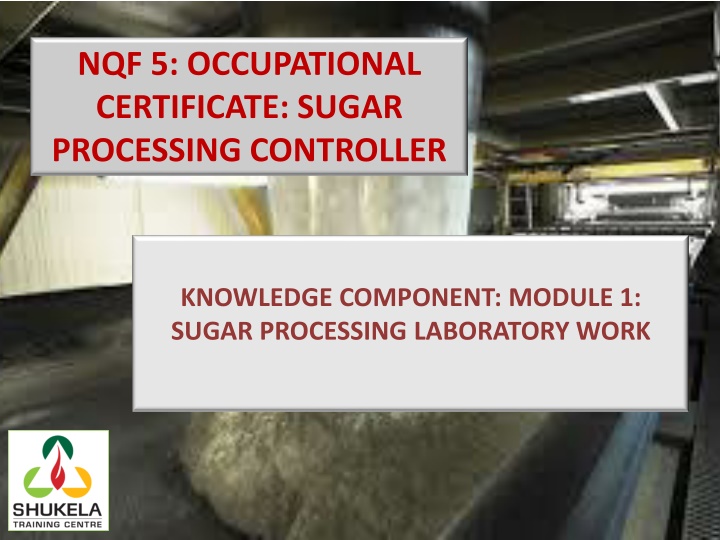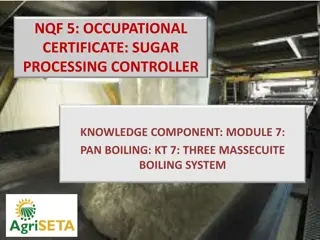OCCUPATIONAL CERTIFICATE: SUGAR PROCESSING CONTROLLER
In the organizational structure of a sugar mill, the Sugar Processing Laboratory plays a critical role in ensuring quality control of raw materials, monitoring production processes, and assessing final products. To meet these objectives, the laboratory needs reliable infrastructure, accurate equipment, well-trained staff, and an efficient analysis plan. Various measurements including sucrose percentage, total soluble solids, fibre percentage, CCS, purity, and dissolved solids are essential and must be conducted with speed, accuracy, reliability, and repeatability. Stakeholders like cane growers and processors rely on laboratory results for crucial decision-making processes.
Download Presentation

Please find below an Image/Link to download the presentation.
The content on the website is provided AS IS for your information and personal use only. It may not be sold, licensed, or shared on other websites without obtaining consent from the author.If you encounter any issues during the download, it is possible that the publisher has removed the file from their server.
You are allowed to download the files provided on this website for personal or commercial use, subject to the condition that they are used lawfully. All files are the property of their respective owners.
The content on the website is provided AS IS for your information and personal use only. It may not be sold, licensed, or shared on other websites without obtaining consent from the author.
E N D
Presentation Transcript
NQF 5: OCCUPATIONAL CERTIFICATE: SUGAR PROCESSING CONTROLLER KNOWLEDGE COMPONENT: MODULE 1: SUGAR PROCESSING LABORATORY WORK
Background In the organisational structure of every sugar mill (sugar processing plant) there is a specific department or division dedicated to QUALITY CONTROL. The Sugar Mill Laboratory is responsible for providing the raw data that describes the quality of the sugar as it moves from one process to another through the factory.
Purpose of the Laboratory The main purposes of the laboratory are: Quality control of raw materials Monitoring of production processes Quality control of final products
The Needs of a Good Laboratory In order to provide quality analytical services, a sugar mill laboratory needs: Good physical infrastructure Accurate and reliable equipment Well-trained technical staff An Efficient analysis plan
Types of Measurements An on-site sugar laboratory measures: pol (sucrose) per cent in juice, brix (total soluble solids) per cent in juice, pol (sucrose) per cent in cane, brix per cent in cane, fibre per cent, commercial cane sugar (CCS), purity, and dissolved solids value.
How must these measurements be made? Greatest speed Least amount of error Reliably Repeatably
Stakeholders of Laboratory Results Cane growers rely on the laboratory results for: their cane payments guidance on how to improve their production practices guidance on how to improve their harvesting practices guidance on how to improve their transportation practices Cane processors rely on these laboratory results: To determine whether the sugar can move onto the next stage of processing in the processing chain To determine whether the equipment is functioning efficiently To determine whether the final product is of the desired quality
Characteristics of a good laboratory worker Neat Diligent Precise Providing quick and accurate results























